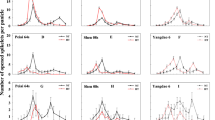Abstract
In order to explore the possible physiological mechanism of high temperature induced sterility in rice, we examined the floret sterility and endogenous plant growth regulator contents in pollens of two hybrid rice cultivars Shanyou63 and Teyou559 that are tolerant and susceptible to high temperature, respectively. Indexes of floret sterility, pollen activity, and variation of endogenous indole-3-acetic acid (IAA), gibberellic acids (GAs), abscisic acid (ABA), free proline and soluble proteins in anthers were measured. We found that during the course of high temperature treatment, both cultivars exhibited a marked decrease in pollen activity, pollen germination and floret fertility; however, the high temperature tolerant Shanyou63 showed a much slower rate of decrease than the high temperature susceptible Teyou559. In addition, anthers of both cultivars displayed a decrease in the contents of IAA, GAs, free proline and soluble proteins but an increase in the ABA content. Yet compared to Teyou559, Shanyou63 retained significantly higher levels of free praline and GAs and a lower level of ABA, along with higher pollen vigour and pollen germination rate even after prolonged high temperature treatment. Our study suggests a possible correlation between pollen viability/floret sterility and high temperature-caused changes in IAA, GAs, ABA, free proline and soluble protein contents. The severity in these changes may reflect the variation of rice cultivars in their heat stress sensitivities for floret development.




Similar content being viewed by others
Abbreviations
- IAA:
-
Indole-3-acetic acid
- GAs:
-
Gibberellic acids
- ABA:
-
Abscisic acid
References
He ZP (eds) (1993) Experimental instruction for crop chemical controls. Peking Agriculture University Publishing House, Peking
Jiang MY, Guo SC, Zhang XM (1997) Proline accumulation in rice seedling exposed to oxidative stress in relation to antioxdation. Acta Phytophysiol Sin 23:347–352 (in Chinese)
Li XZ, Liang MZ, Zhou GQ (2002) Effect of environment condition on pollen activity and seed set during flowing time of rice. Acta Agron Sin 28:417–420 (in Chinese)
Mackill DJ, Coffman WR, Rutger JN (1982) Pollen shedding and combining ability for high temperature tolerance in rice. Crop Sci 22:730–733
Matsui T, Omasa K (2002) Rice (Oryza sativa L.) Cultivars Tolerant to High Temperature at Flowering: Anther Characteristics. Ann Bot 89:683–687
Matsui T, Omasa K, Horie T (2000) High temperatures at flowering inhibit swelling of pollen grains, a driving force for thecae dehiscence in rice (Oryza sativa L.) Plant Prod Sci 3:430–434
Matsui T, Omasa K, Horie T (2001) The difference in sterility due to high temperatures during the flowering period among japonica-rice varieties. Plant Prod Sci 4:90–93
Matsushima S, Ikewada H, Maeda A et al (1982) Studies on rice cultivation in the tropics. 1. Yielding and ripening responses of the rice plant to the extremely hot and dry climate in Sudan. Jpn J Trop Agric 26:19–25
Nakajima M, Yamaguchi I, Kizawa S (1991) Semi-quantification of GA1 and GA4 in male sterile anthers of rice by radioimmunoassay. Plant Cell Physiol 32:511–513
Plif G (1981) The proline content and fertility of the pollen in breed maize lines. Acta Bet Acad Sci 27:179–181
Satake T, Yoshida S (1978) High temperature-induced sterility in indica rice at flowering. Jpn J Crop Sci 47:6–10
Shimizu M, Kuno K (1967) Some cyto-histo logical observations on the morphogenetically abnormal rice spikelets caused by a low temperature. Proc Crop Sci Soc Jpn 36:489–502
Smirnoff N (1993) The role of active oxygen in the response of plant to water deficit and desiccation. New Phytol 125:27–32
Song J, Nada K, Tachibana S (1999) Ameliorative effect of polyamines on the high temperature inhibition of in vivo pollen germination in tomato (Lycopersicon esculentum Mil.) Sci Hortic 80:203–212
Tan ZH, Lan TY, Ren CF (1985) Studies on high temperature injury on hybrid rice at flowering time and the strategy to avoid high temperature damage. Acta Agronom Sin 11:103–108 (in Chinese)
Tang RS, Mei CS, Zhang JY (1996) Relationship between rice male sterility induction by T03 and level of endogenous hormones. Jiangsu J Agric Sci 12:6–10 (in Chinese)
Tang RS, Zheng JC, Zhang DD (2006) The effects of high temperatures on pollen vitality and seed setting of different rice varieties. Jiangsu J Agric Sci 22:369–373 (in Chinese)
Weiler EW, Jordan PS, Conrad W (1981) Levels of indole-3-acetic acid in intact and decapitated coleoptiles as determined by a specific and highly sensitive solid-phase enzyme immunoassay. Planta 153:561–571
Yang DC, Zhu YG, Tang LJ (1990) The content of four endogenous hormones in leaves and fertility transformation of HPGMR. J Huazhong Agric Univ 9:394–399 (in Chinese)
Zhang B, Tang XH (1992) Studies on rice embryo proteins with developmental stage specificity. Acta Pytophysiol Sin 18:85–92 (in Chinese)
Acknowledgements
This work was financially supported by Natural Science Foundation of Jiangsu Province of P. R. China (Grant No. BK2004002) and National Natural Science Foundation of P. R. China (Grant No. 30470332).
Author information
Authors and Affiliations
Corresponding author
Rights and permissions
About this article
Cite this article
Tang, RS., Zheng, JC., Jin, ZQ. et al. Possible correlation between high temperature-induced floret sterility and endogenous levels of IAA, GAs and ABA in rice (Oryza sativa L.). Plant Growth Regul 54, 37–43 (2008). https://doi.org/10.1007/s10725-007-9225-8
Received:
Accepted:
Published:
Issue Date:
DOI: https://doi.org/10.1007/s10725-007-9225-8




